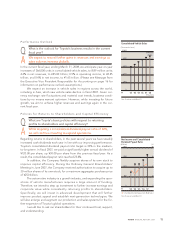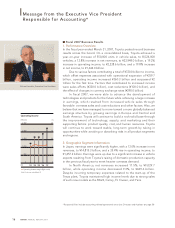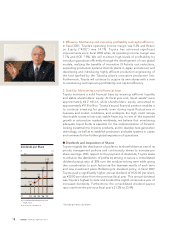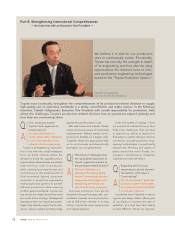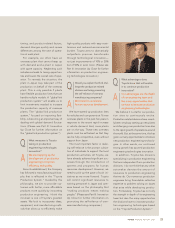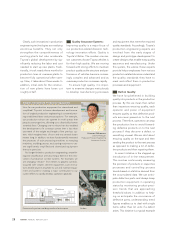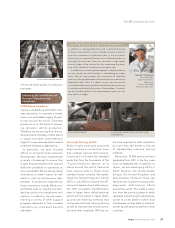Toyota 2007 Annual Report Download - page 24
Download and view the complete annual report
Please find page 24 of the 2007 Toyota annual report below. You can navigate through the pages in the report by either clicking on the pages listed below, or by using the keyword search tool below to find specific information within the annual report.
22 ANNUAL REPORT 2007
First, would you explain
Toyota’s basic approach to
manufacturing?
Our basic philosophy is to
“build vehicles where demand is
found” while relentlessly inno-
vating production engineering.
Toyota is strengthening its produc-
tion in line with two overall strategies.
First, we build vehicles where the
demand is found. By manufacturing in
regions where demand exists, we shorten
lead time from order to production
while creating local employment and
contributing to the development of
local economies. Second, we pursue
innovation in production engineering
technologies and systems to achieve
efficient production while ensuring
uniform quality worldwide. Toyota now
has production bases around the world
as a result of this strategy. Widespread
operations have two significant advan-
tages; they steadily supply Toyota vehi-
cles to various markets and they hedge
against demand fluctuation risks.
We seek kaizen and kaikaku. Kaizen
means continuous pursuit of incremental
improvements. Kaikaku means revolu-
tionizing for benefits on a bigger scale.
Together, these two approaches help
us to continuously and dramatically
strengthen our competitiveness.
What kind of challenges does
the rapid global expansion of
Toyota’s operations present to
the production-related divisions?
The main challenges are
catering to fluctuating global
demand, innovating production
engineering technologies, and
establishing self-reliant over-
seas manufacturing companies.
Overseas production has almost
doubled in the past five years, with con-
solidated overseas annual production
now at 3.08 million vehicles. In its long
history, Toyota has never experienced
such rapid expansion.
Given the speed of change, I think
our production-related divisions face
three main challenges. First, we have
to improve our ability to respond to
fluctuations in global demand. Second,
we need to innovate production engi-
neering technologies to significantly
improve the efficiency and quality of
plants around the world. Finally, our
overseas manufacturing companies
must become more self-reliant.
Regarding the first issue,
responding to global demand
fluctuations, what steps is
Toyota taking?
We are developing a “global link
production system” that enables
us to respond rapidly and flexibly
to changes in demand.
It would be easy if demand in various
regions was always stable, allowing all
of our plants to maintain the rate of
operation at a high level. But reality
proved different. Driven by regional,
Part II: Strengthening International Competitiveness
—An Interview with an Executive Vice President —
Q
A
Q
A
We believe it is vital for our production
sites to continuously evolve. Fortunately,
Toyota has not only the strength in depth
of its engineering team but also the many
opportunities the divisions have to inno-
vate production engineering technologies
based on the “Toyota Production System.”
Takeshi Uchiyamada,
Executive Vice President, Production
We believe it is vital for our production
sites to continuously evolve. Fortunately,
Toyota has not only the strength in depth
of its engineering team but also the many
opportunities the divisions have to inno-
vate production engineering technologies
based on the “Toyota Production System.”
Takeshi Uchiyamada,
Executive Vice President, Production
Q
A
Toyota must continually strengthen the competitiveness of its production-related divisions to supply
high-quality cars to customers worldwide in a timely, cost-efficient, and stable manner. In the following
interview, Takeshi Uchiyamada, Executive Vice President with overall responsibility for production, talks
about the challenges Toyota’s production-related divisions face as operations expand globally and
how they are overcoming them.





